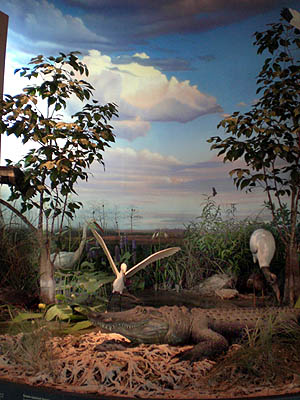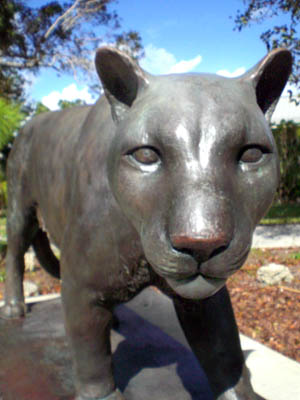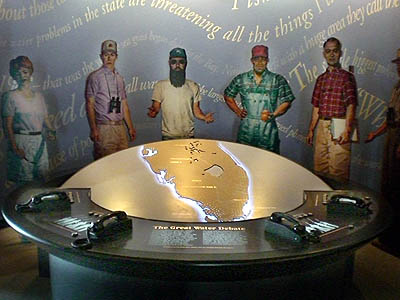
Everglades offer adventure in an afternoon
FLORIDA CITY, Fla. — Dozens of miles away from the Miami skyline and at the end of the Florida Turnpike are the Everglades, one of the sunshine state’s last anomalies that has not been developed or turned into a strip mall.
Approximately 1.5 million acres in size, the Everglades National Park, although vast, can be enjoyed in a small fragment of time, such as an afternoon, particularly through the Ernest F. Coe Visitor Center near here.
As one of three Visitor Centers the park has to offer (the others are located along Tamiami Trail and in Everglades City), this center is the ideal park gateway to visit as a pit stop on the way to the Florida Keys or into Miami.
 |
An exhibit highlights wild birds of Everglades National Park in the Coe Visitor Center near Florida City (Photos by Michael Viera). |
“We get a lot of visitors on their way to other places here,” said Park Ranger Barbara Maguire, who has been at the center for three years. “We offer a lot of programs throughout the day that people can view that aren’t really time consuming.”
Boasting interactive programs that will pique the interest of children and nature lovers alike, the visitor center can be experienced in under an hour.
Interactive displays about the environmental importance of the Everglades can be enjoyed in less than five minutes and educational short films play around the clock in the intimate auditorium.
These features are accentuated by lifelike displays of the popular Florida alligator and other wildlife that add atmosphere to the building. Artist interpretations of Egrets hang off the ceiling as an intimidating ceramic alligator stalks its prey near a life-like swamp.
These simulations, although aesthetically appealing, do not compare to the real thing which can be experienced just outside the Visitor Center doors.
The park offers a variety of ways in which guests can experience the wetlands that are home to a variety of animals. The most popular option with guests at the park is the bike rides, which are allowed on the 28-mile Long Pine Key Trail.
“The bike rides are a good way to experience the park because it is affordable and guests get a good amount of exercise,” Maguire said. “It’s a great way to experience the park in a short amount of time.”
The bicycling trail, which is included in the $10 entrance fee for the park, travels through the heart of the Everglades carving its way through trees and marshes.
 The trail is especially beneficial to bird watchers, according to Miami native Virginia Gil.
The trail is especially beneficial to bird watchers, according to Miami native Virginia Gil.
“I’ve seen a lot of birds here on this trail,” said Gil, who travels to the Everglades once a year. “The variety of wildlife that you see while biking is spectacular, you really feel at one with nature,” she said
This feeling of harmony in the Everglades is infectious. The mangroves unite with skyscraper-like trees to create canopies throughout the trail that house animals in the cool winter months. The trail is an excellent experience to see nature at work and in repair.
Much of the trail has been ravaged by the hurricane season of 2005, but signs of nature healing itself are already visible.
“A lot of trees that fell down are actually used by the wildlife for other purposes now,” Maguire said. “Nature always has a way of being amazing.”
For the trails that cannot be navigated via bicycle, the Everglades also offers hiking trails for those willing to stalk the same grounds as Florida Panthers and alligators. The visitor center promotes hiking tours offered by park rangers that begin as early as 10:30 a.m.
Ranger Manuel Hernandez, who conducts the tours on weekends, cites the tours as his favorite part of being a park ranger.
“During the weekends we get a lot of people who don’t stay in the park for long, and they come on the tours since they are relatively short,” Hernandez said. “I try to pack in a lot of information in a 50-minute tour so that people spend their time efficiently.”
Hernandez does a tour on the Anhinga Trail, which is a prime spot for viewing alligators and turtles in their swamp habitats. He is well aware that people come to him with one thing in mind: alligators.
“The alligators are what most people come to see,” Hernandez admitted. “On my tour you usually see an alligator or two. It’s a great way to get the most bang for your buck.”
This is especially true in the winter season where many alligators are strewn across the swamp grounds, either in the water or on land. The close proximity to the alligators is daunting yet fascinating since there are no barriers between them or park visitors.
Hernandez sees the lack of fences and glass shields as a selling point to visit the park.
“Sure Metrozoo is close to us here and they have their own alligators,” Hernandez said. “But here you can see them up close and personal without a moat or a five-inch glass acting as a barrier.”
 Even the turtles, which are stuffed into their tropically exotic shells, peek out at park visitors and continue on their way.
Even the turtles, which are stuffed into their tropically exotic shells, peek out at park visitors and continue on their way.
The experience is noticeably different than that of a zoo, primarily because the animals are in their own habitat.
Claire Barton, a resident of Illinois, came to the Everglades as a park stop in her visit to Miami.
“Miami nightlife is known for being wild and crazy,” Barton said as an alligator laid about 20-feet away lost in his own world of peace. “But this is probably wilder and crazier than anything else I am going to see while I am down here.”
If You Go
- Address: 40001 State Road 9336, Homestead, Fla. 33034.
- Those coming from north of the Everglades, the Visitor Center is just off the Florida Turnpike on State Road 9336. If coming from the Florida Keys, turn right onto Palm Drive and follow the signs to the park.
- Phone number: 305-242-7700.
- Hours: November to April 8 a.m. to 5 p.m., May to October 9 a.m. to 5 p.m.
- Entrance fee: $10 for vehicles, $5 for those on foot and on bicycles.
- Visitor Center is fully accessible to those in wheelchairs with bathroom facilities on site.
- Attempt to see one of the seasonal exhibits held in the Visitor Center.
- Ask a helpful park ranger what programs are going on which vary throughout the day in order to get the most out of the time you are there.
- Take bug spray, especially in the summer months where humidity is at its highest.
- Flash photography of wildlife is not encouraged.
- Wear comfortable shoes and loose clothing.

Comments are Closed